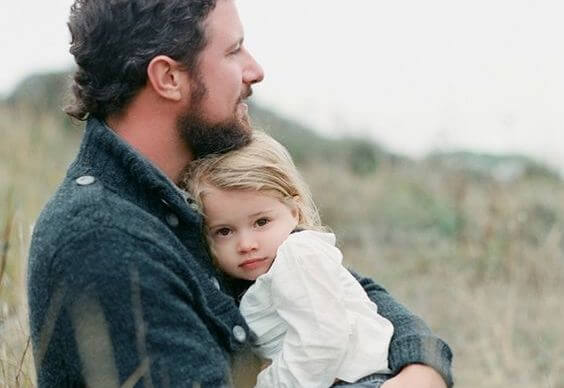Scents of Childhood: Doors To Our Emotional Past

Crayons, chocolate cake, freshly cut grass in the summer, our grandparents’ house and the perfume of our mother when she hugged us. The scents of childhood inhabit our brain like doors left ajar, like powerful anchors to an emotional past to.
Psychologists use the phrase “Fragrant Flashbacks” to refer to the intimate relationship between memory, smell and our childhood. Up to 5 years of age, the way a child integrates memories is closely related to smell, but as we grow older, sight and hearing begin to outweigh this sense.
Children have their own way of feeling and understanding the world. We cannot substitute it; children must complete gather their own “experiential trunk” of positive encouragement, affection and wonderful discoveries.
The relationship between scent and childhood memories has not really been explored in depth. However, scientists like Dr. Maria Larsson reveal that in fact, the nose is the “physical input” to our emotional world.

Scents of childhood: a direct link to our emotions
Helen Fields, writer and expert in medicine for the Smithsonian, explains in her book Fragrant Flashbacks that during our early childhood, smell and taste together are our most important “chemical channels” for understanding the world. Past the age of five, we no longer have the need to put things in our mouth and our nose also stops being as receptive.
We might think of smell as a sense in which only sommeliers or perfumers are experts, but, in fact, it’s the most powerful channel that connects with our brain. In turn it is able to activate emotions and very specific memories.
“There is only one smell that can compete with the smell of a storm: the smell of a wooden pencil.”
– Ramon Gomez de la Serna –

How smells activate emotions
When the molecules of the scent of a flower or wet earth, for example, bind to the lining of our nose, they send a signal directly to the olfactory bulb, a small and sophisticated structure located just above our eyes.
From here a fascinating journey begins that will carry the signal to two specific channels. First to the primary olfactory cortex so it can identify and classify that smell. Later, that olfactory signal will go to the amygdala, an area related to emotions, below the hippocampus which is also responsible for our memory.
According to a study carried out in the 1990s in the Monell Chemical Sciences Center in Philadelphia, babies are already receptive to smell before birth. Through amniocentesis it was found that the diet of the mother can be perceived “in smells” through amniotic liquid, and therefore, the fetus begins learning very early.
As we can see, for a very specific reason, smell will always go hand in hand with emotions. A pleasant smell not only gives us comfort or evokes positive memories, but can also encourage us to consume more. Hence, many stores already use neuromarketing to take advantage of the power of our emotions through smell.

Olfactory memory therapy
We’ve all experienced these childhood smells that come suddenly and when we least expect it. When you open an old book and feel a strange “déjà vu”, or associate the fragrance of cinnamon pie that our grandmother used to make…
Remember that there may come a time that we lose “this magical path” that connects the smell with emotion. And this is exactly what happens early on in the development of Alzheimer’s or Parkinson’s.
There are very interesting therapies that seek to stop the loss of olfactory memory through stimulation. It’s also possible that these therapies can be used to stop, as far as possible, memory loss.
It is a known fact that in the case of Alzheimer’s, the emotional aspect is alive and very active. Hence, using smell as a mechanism to activate memory through emotions is certainly an interesting possibility to keep in mind.

Exercises such as taking a walk after a rainy day, allowing the fragrances of the kitchen to spread, or smelling freshly washed clothes. These might be daily exercises to slow down the disease and, above all, enhance the well-being of the patient by promoting the recollection of significant moments of their past.
The scents of their childhood, for example…
Crayons, chocolate cake, freshly cut grass in the summer, our grandparents’ house and the perfume of our mother when she hugged us. The scents of childhood inhabit our brain like doors left ajar, like powerful anchors to an emotional past to.
Psychologists use the phrase “Fragrant Flashbacks” to refer to the intimate relationship between memory, smell and our childhood. Up to 5 years of age, the way a child integrates memories is closely related to smell, but as we grow older, sight and hearing begin to outweigh this sense.
Children have their own way of feeling and understanding the world. We cannot substitute it; children must complete gather their own “experiential trunk” of positive encouragement, affection and wonderful discoveries.
The relationship between scent and childhood memories has not really been explored in depth. However, scientists like Dr. Maria Larsson reveal that in fact, the nose is the “physical input” to our emotional world.

Scents of childhood: a direct link to our emotions
Helen Fields, writer and expert in medicine for the Smithsonian, explains in her book Fragrant Flashbacks that during our early childhood, smell and taste together are our most important “chemical channels” for understanding the world. Past the age of five, we no longer have the need to put things in our mouth and our nose also stops being as receptive.
We might think of smell as a sense in which only sommeliers or perfumers are experts, but, in fact, it’s the most powerful channel that connects with our brain. In turn it is able to activate emotions and very specific memories.
“There is only one smell that can compete with the smell of a storm: the smell of a wooden pencil.”
– Ramon Gomez de la Serna –

How smells activate emotions
When the molecules of the scent of a flower or wet earth, for example, bind to the lining of our nose, they send a signal directly to the olfactory bulb, a small and sophisticated structure located just above our eyes.
From here a fascinating journey begins that will carry the signal to two specific channels. First to the primary olfactory cortex so it can identify and classify that smell. Later, that olfactory signal will go to the amygdala, an area related to emotions, below the hippocampus which is also responsible for our memory.
According to a study carried out in the 1990s in the Monell Chemical Sciences Center in Philadelphia, babies are already receptive to smell before birth. Through amniocentesis it was found that the diet of the mother can be perceived “in smells” through amniotic liquid, and therefore, the fetus begins learning very early.
As we can see, for a very specific reason, smell will always go hand in hand with emotions. A pleasant smell not only gives us comfort or evokes positive memories, but can also encourage us to consume more. Hence, many stores already use neuromarketing to take advantage of the power of our emotions through smell.

Olfactory memory therapy
We’ve all experienced these childhood smells that come suddenly and when we least expect it. When you open an old book and feel a strange “déjà vu”, or associate the fragrance of cinnamon pie that our grandmother used to make…
Remember that there may come a time that we lose “this magical path” that connects the smell with emotion. And this is exactly what happens early on in the development of Alzheimer’s or Parkinson’s.
There are very interesting therapies that seek to stop the loss of olfactory memory through stimulation. It’s also possible that these therapies can be used to stop, as far as possible, memory loss.
It is a known fact that in the case of Alzheimer’s, the emotional aspect is alive and very active. Hence, using smell as a mechanism to activate memory through emotions is certainly an interesting possibility to keep in mind.

Exercises such as taking a walk after a rainy day, allowing the fragrances of the kitchen to spread, or smelling freshly washed clothes. These might be daily exercises to slow down the disease and, above all, enhance the well-being of the patient by promoting the recollection of significant moments of their past.
The scents of their childhood, for example…
This text is provided for informational purposes only and does not replace consultation with a professional. If in doubt, consult your specialist.







